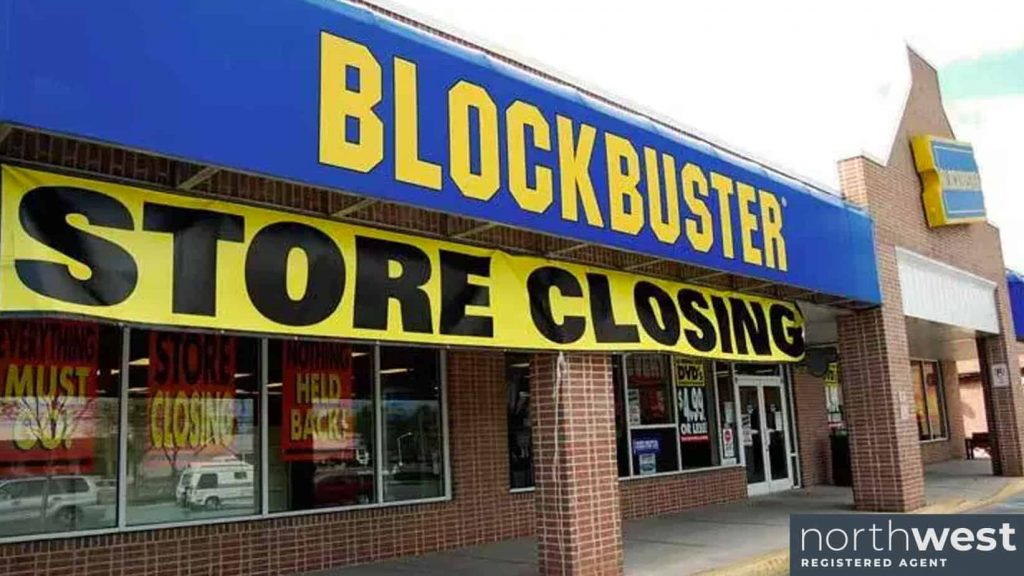What Can Your Business Learn From Blockbuster’s Mistakes

As a small business owner, you should always have your eyes to the future. Businesses come and go. If you want your small business to be profitable for the long haul, you cannot hesitate to innovate. Even in niche markets, without much competition, striving to perfect and update your products or services is your best bet to beat or stifle your competition. A perfect and tragic example of what can happen when you don’t stay ahead of the times… Blockbuster.
The smell of burnt popcorn and lead-based plastic movie cases. The apathetic teenage cashiers that couldn’t process a transaction in a timely manner if they were held at gunpoint. The multi-use carpet that looked like it was painted by Jackson Pollack. I suppose they also had VHS/DVDs you could rent as well, and If you were anywhere remotely as irresponsible as myself, you definitely remember the daily late fees.
Fifteen years ago, there were close to 9,000 Blockbuster franchises and Redbox was just a fledgling start up that specialized in vending machines that sold milk, eggs, and other groceries. Obviously, Redbox changed their business model. Blockbuster didn’t. Today there are over 40,000 Redbox kiosks in the United States, and there is one solitary Blockbuster in Bend, Oregon. There are 6 different Redbox kiosks within one mile of that single Blockbuster. That’s not to mention the innumerable nails Netflix put in Blockbuster’s coffin. The facts must be faced: Blockbuster is dead.
When you think about innovation, it’s not about flying cars, or robots that serve you daiquiris. It’s as simple as anticipating what your customers are going to want next. This way you can be ready for what customers will need. Or better yet, you can tell them why they need it. While Blockbuster seemed more than happy hemorrhaging market share for a decade, Netflix and Redbox continue to change the home-media game.
Remember when Netflix first started? It all started with mailing DVDs to your home. Now, critically acclaimed televisions shows stream at the click of a button on televisions optimized for the Netflix viewing experience. Meanwhile, Redbox pivoted from their grocery vision and become a DVD rental giant. Both companies innovated to stay alive, while Blockbuster idly withered away.
Though many are still nostalgic for and grieve the loss of bright florescent lights and novelty neon candy, an all-to-true fact remains evident: the best thing you can do for the future of your small business is to stay hungry. While Blockbuster grew complacent with its huge market share and multitude of storefronts, Redbox and Netflix disrupted the market forever. So what’s the secret?
Know your customer, anticipate their needs and push yourself to stay ahead of the curve. If you own a restaurant, make sure to keep up with what types of entrees might be on the come up, and be the first eatery in town to have it on the menu. If you have a vintage store on Etsy, make sure to keep up on the hipster trends and keep your inventory fresh. If your business provides a service or experience, never stop asking yourself what you can modify to enhance your customer satisfaction. Essentially, analyze what you can do with your products or services to expect what your customers will need next. If your business doesn’t do it, someone else will.
It’s plausible that someday soon you could read an article just like this one, chronicling how and why Redbox went the way of the dodo bird. After all, Redbox’s rental numbers peaked in 2013, and their amount of active kiosks nation-wide hasn’t grown since 2012. Once again, Netflix is the killer in the night, and once again, their weapon is innovation. The biggest challenge both companies faced was negotiating distribution deals with major movie studios like Disney and Universal–with the movie studios largely deciding how soon they could rent/stream their films, and at what cost.
So with a little bravery and a hell of an progressive idea, Netflix decided to cut out the middle man and invest billions into producing and filming its own original content. The venture has yielded bonafide hits like: “House of Cards,” “Stranger Things,” and “Orange is the New Black.” They even went so far as to resurrect the early 2000s hit “Arrested Development.” While Redbox still pays abhorrent licensing fees to studios, Netflix’s flagship programs are entirely its own intellectual property. Netflix’s subscriber count has increased by a higher percentage every year since the original content premiered, and its stock price rose 73% percent in 2018.
I’ve spent the majority of this article highlighting the innovations of the victors, but in conclusion, I’d like to remind you that this blog is about what you can learn from Blockbuster. Netflix and Redbox retired all but one Blockbuster, and they did it through pivoting and changing how we consume home media. If you have high hopes for your budding business, knowing how creative a couple of other companies were in the past isn’t going to help you at all. Every company, and every market is different. So when you decide to make changes to your products or services, there’s usually a risk involved. Understandably, that risk is scary. To its own demise, Blockbuster never took it. And for that, we weep.
In order to drive my point home, I’ve decided to end on a fact that would have made a lot more sense in the intro:
Back in the year 2000, Netflix had over 300,000 subscribers and its partners approached Blockbuster to buy their company outright for $50 million. Blockbuster obviously declined. Today, Netflix is worth over 20 billion.
P.S. The world’s last Blockbuster is open 7 days a week and has one of the funniest twitters I’ve ever seen.
https://twitter.com/loneblockbuster
P.P.S. If you are in Bend, Oregon and make a stop to take a selfie in front of the last Blockbuster, at least go in and buy some Skittles or something… have you no shame?



